With Walk East ...
[video v=AaaD8lNkRdw]Bonus film - the Singing Sand Dunes of GanSu ...
Plus more videos ...
Live more ...
With Walk East ...
[video v=AaaD8lNkRdw]Bonus film - the Singing Sand Dunes of GanSu ...
Plus more videos ...
With Blondie in China ...
[video v=0xsMvOzn0wM] Plus more videos ...
With Walk China ...
[video v=o7PeD7koeh8]The grasslands of Gansu Province are a breathtaking natural wonder, offering vast expanses of rolling hills, lush meadows, and vibrant wildflowers. These grasslands are home to diverse wildlife and traditional nomadic cultures, providing visitors with a unique and immersive experience. This guide will help you explore the beauty of Gansu's grasslands, including must-see attractions, local culture, and practical travel tips.
Maqu Grassland, located in the southern part of Gansu Province, is one of the most beautiful and well-preserved grasslands in China. The area is known for its rich biodiversity, including rare species of plants and animals. Visitors can experience traditional Tibetan nomadic culture, including horseback riding and staying in yurts.
Gannan Tibetan Autonomous Prefecture is a region in Gansu known for its stunning landscapes and vibrant Tibetan culture. The grasslands here are dotted with monasteries, prayer flags, and nomadic camps. Highlights include the Labrang Monastery, one of the six great monasteries of the Gelug school of Tibetan Buddhism, and the Sangke Grassland, a perfect spot for camping and picnicking.
Ruoergai Grassland, also known as Zoige Grassland, is located at the border of Gansu and Sichuan provinces. It is one of the largest and most picturesque grasslands in China, featuring vast wetlands, rivers, and lakes. The area is home to numerous bird species, making it a paradise for bird watchers.
Langmusi is a small town located on the border of Gansu and Sichuan provinces, known for its beautiful grasslands and Tibetan Buddhist monasteries. The town is surrounded by lush meadows and mountains, offering excellent opportunities for hiking and horse riding. The local monasteries, such as the Kirti Monastery and Sertri Monastery, are also worth visiting.
The grasslands of Gansu are home to a diverse range of ethnic groups, including Tibetans, Mongolians, and Hui Muslims. These communities have preserved their traditional ways of life, including nomadic herding, Tibetan Buddhism, and unique culinary traditions. Visitors can immerse themselves in local culture through homestays, attending festivals, and participating in traditional activities.
Tibetan festivals are an integral part of the cultural landscape in Gansu's grasslands. Key festivals include Losar (Tibetan New Year), Shoton (Yogurt Festival), and the Horse Racing Festival. These events feature traditional music, dance, religious rituals, and sports competitions, providing a vibrant and immersive cultural experience.
Experiencing the traditional nomadic lifestyle is a highlight of any visit to the grasslands. Visitors can stay in yurts, ride horses, and learn about the herding practices that have sustained these communities for centuries. This offers a unique insight into the symbiotic relationship between the nomads and their natural environment.
The grasslands of Gansu Province offer a unique and unforgettable travel experience, combining stunning natural landscapes with rich cultural heritage. Whether you're exploring the vast meadows, learning about nomadic traditions, or immersing yourself in Tibetan culture, the grasslands of Gansu provide a deep and enriching connection to the natural and cultural wonders of China. Use this guide to plan your journey and make the most of your visit to this extraordinary region.
With Little Chinese Everywhere ...
[video v=cXWEbPNfh0A]With Walk East ...
[video v=bKEMqE6Ooic]GanSu province.
With Walk East ...
[video v=bKEMqE6Ooic] Plus more videos ...
With Rafa Goes Around! ...
[video v=BoT1BsUFHBU]Bonus film - The Singing Sand Dunes | Dunhuang, Gansu Province | 敦煌鸣沙山 - with Walk East ...
Plus more videos ...
GanSu's UNESCO World Heritage Site ...
[video v=-NUkxiZmYx0]With Walk East - the Great Wall of China.
JiaYu Pass is not only the western starting point of the Ming Great Wall, but also a vital pass on the ancient Silk Road. It's the joining place of the cultures of the Silk Road ...
[video v=X_TeKhYoIHk]China 中国 from the air - a breathtaking journey ...
These amazing films capture the beauty of nature and city ... Don't miss it ! The best videographers. The best music. Turn up the volume; relax; let's go ... Hong Kong The Great Wall (JinShanLing / SiMaTai, close to Beijing) QingHai province JiuZhaiGou and HuangLong, SiChuan province Crescent Moon Spring / Lake, 6 km from DunHuang, GanSu province, north west China Guilin and YangShuo, GuangXi province The Tibetan Plateau, far south west China HuiZhou, GuangDong province, south east China TianShan Mountain area, XinJiang province, far west China MoGao Grotto, YuMenGuan, YangGuan, JiaYuGuan, YaDan, DanXia; all in GanSu province Tian Tan Giant Buddha, Hong Kong GuangZhou, provincial capital of GuangDong and close to Hong Kong Various places in China
Crescent Moon Lake, an oasis in the Gobi desert
A few of the lesser known beauty spots in China ...
BingLing Temple 炳灵寺 Grottoes, YongJing, GanSu province
A beautiful series of grottoes filled with Buddhist sculpture carved into natural caves and caverns in a canyon along the Yellow River. It lies just north of where the Yellow River empties into the LiuJiaXia Reservoir.
Fun adventures in DunHuang 敦煌, western GanSu province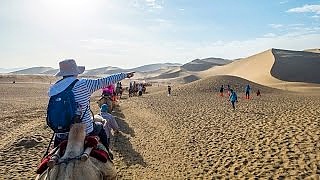
DunHuang is situated in a rich oasis within the Gobi Desert that includes Crescent Lake. DunHuang held a strategic position at the crossroads of the ancient Southern Silk Route and the main road leading from India via Lhasa to Mongolia and Southern Siberia, as well as the entrance to the narrow HeXi Corridor, which led straight to the heart of the northern China plains and the ancient capitals of Chang'An (known today as Xi'An) and LuoYang. The Gobi Desert is a 'rain shadow desert', formed by the Himalayan mountain range blocking rain-carrying clouds from the Indian Ocean.
YinChuan, 'Silver River', lies in NingXia province, central - north China. It is located near the western bank of the upper course of the Yellow River, in the south-central section of the HeLan Shan mountains and the Ordos Desert. Thanks to the Yellow River, YinChuan enjoys beautiful natural scenery and favorable conditions for agriculture and has long earned the fame of a "River Side City in the Northwest" and "Home to Fishes and Rice". Around the city of about 2 million are a number of interesting cultural sites, including part of the Great Wall of China (not far from the western end-point) and grand mosques (Hui minority) and lies on a trade route from cities in the far west to the east. Nearby are the extensive Western Xia Dynasty (1038 - 1227) Tombs, 40 kilometers to the west. There are two pagodas in YinChuan that are part of the 'Eight Famous Sceneries of NingXia': one is the HaiBao Pagoda in the northern suburb and the other is the ChengTianSi Pagoda in the west. Sand Lake lies about 50 kilometers north of YinChuan. Being a world of desert and a large lake, it is a place of beautiful nature and a great getaway. The immediate plains area, intensively irrigated by a system developed as long ago as the Han dynasty (206 BC–AD 220), is very productive for agriculture. A great film by Sticker Travel ...
JiaYuGuan 嘉峪关 - the western end of the Great Wall of China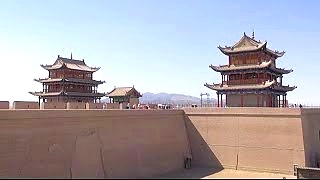
Plus DunHuang oasis and ZhangYe DanXia GeoPark, all in GanSu province.
Two months in China's south west 中国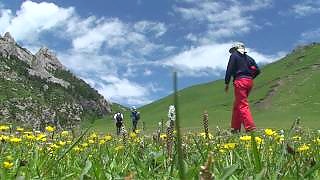
Highlights of an eight week trip though Tibet, YunNan, SiChuan, GanSu and QingHai provinces (2007).
XiaMen, FuJian province, Urumqi, XinJiang province, and DunHuang, GanSu province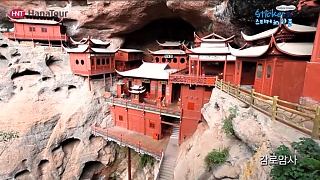
A few of the great China videos by Stick2r ...
DunHuang 敦煌, GanSu province : along the old Silk Road
Explore the beautiful ancient town and surrounding sand-dunes and Buddhist caves with Sticker Travel. The second film shows the Silk Road DunHuang Hotel. DunHuang lies at the eastern end of the old northern Silk Route, from the ancient capital of Xi'An westwards to Kashgar in XinJiang province. The Great Wall was extended westwards to here around 120 BCE during the Han dynasty (202 BCE - 220 AD). During the Han and Tang dynasties, in particular, it was an important point of communication between China and central Asia.
The MaiJiShan Grottoes 麦积山石窟, TianShui, GanSu province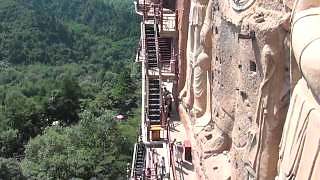
The MaiJiShan Grottoes are filled with thousands of Buddhist sculptures. These were carved from the Wei dynasty to the Song dynasty by Buddhist monks who first came here via the North Silk Road. The grottoes are close to TianShui, which is the second largest city in GanSu province in central China, with a population of approximately 3.5 milion. The city lies along the route of the ancient Northern Silk Road by the Wei River, through which much of the trade flowed between China and the West. The Qin state, the founding dynasty of China, arose in this part of China.
A trip to DunHuang 敦煌 in the Gobi Desert
DunHuang lies within an oasis in the Gobi Desert, GanSu province. It was an important stop along the Silk Road.
A trip to JiaYuGuan 嘉峪关, western end of the Great Wall - video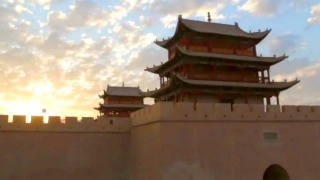
JiaYuGuan is the first pass at the western end of the Great Wall of China. It lies 6 kilometers southwest of the city of JiaYuGuan in GanSu province. The fortress lies between two hills and near to an oasis that was then on the western edge of China. According to legend, when JiaYuGuan was being planned, the official in charge asked the designer to estimate the number of bricks required; the designer surprised the official by giving him an exact number. The official questioned his judgment, asking him if he was sure that would be enough, so the designer added one brick to the total. When JiaYuGuan was finished, there was one brick left over, which was placed loose on one of the gates, where it remains today. Nearby are the DunHuang Caves (also known as the MoGau Caves); these grottoes date from the 4th century AD and contain Buddhist art from over the next thousand years.
Silk Road travels, including JiaYuGuan and DunHuang - video
Scenes along the Silk Road in China. Places include Hohhot (Inner Mongolia), YinChuan (NingXia), LanZhou (Gansu), TianShui (Gansu), ZhangYe (Gansu), JiaYuGuan (Gansu), DunHuang (Gansu), Urumqi (XinJiang). Most notably, the western end of the Great Wall at JiaYuGuan and the Grottoes at DunHuang.
Labrang Monastery, GanSu 甘肃 province
The Labrang Monastery is one of the six great monasteries of the Gelugpa (Yellow Hat) school of Tibetan Buddhism; it stands at the foot of Phoenix Mountain, facing Dragon Mountain.